|
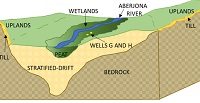
|
|
A Civil Action - the Woburn Trial (Basic Version)
In 1972 in the town of Woburn, Massachusetts, families of 13 different children who had contracted a rare form of childhood leukemia sued two large companies for the contamination of their community water supply wells. But the companies denied any responsibility, arguing that water originating from their plants may never be able to reach the community wells given the local hydrogeologic conditions. Instead, the companies blamed the heavily polluted Aberjona River as the source of contamination to the wells, given it's very close proximity to the community wells. You be the judge... who is responsible?!? Revisit the famous trial as modern-day ‘expert consultants’, addressing the debate issues based on the interpretation of groundwater flow and contaminant transport simulations. (PURELY FORWARD MODELING - NO CALBRATION)
(Featured Active Learning Projects- 24)
|
|

|
|
A Civil Action - the Woburn Trial (Advanced Version)
In 1972 in the town of Woburn, Massachusetts, families of 13 different children who had contracted a rare form of childhood leukemia sued two large companies for the contamination of their community water supply wells. But the companies denied any responsibility, arguing that water originating from their plants may never be able to reach the community wells given the local hydrogeologic conditions. Instead, the companies blamed the heavily polluted Aberjona River as the source of contamination to the wells, given it's very close proximity to the community wells. You be the judge... who is responsible?!? Revisit the famous trial as modern-day ‘expert consultants’, addressing the debate issues based on the interpretation of groundwater flow and contaminant transport simulations. (INVOLVES MODEL CALIBRATION)
(Featured Active Learning Projects- 24)
|
|
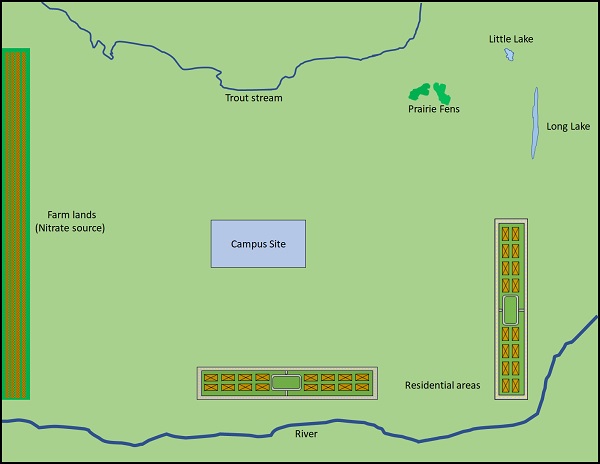
|
|
System-based Water Supply Feasibility Analysis and Design (NEW version!)
A university is planning to build an extension campus near a city, but there may be a "drinking water supply issue" - the large river in the area freezes over in the winter, and the groundwater availability in the in the area is constrained by existing users, ecological constraints, and potential contamination sources. Use a system-based approach to design and analyze a water supply system for the new campus.
(Featured Active Learning Projects- 24)
|
|

|
|
Drinking Water Contamination Dispute
Homeowners in a small community filed a lawsuit against a nearby food processing plant for the contamination of their water wells with heavy metals. They claimed that the source of the problem is the food processing company’s spray irrigation of its waste water at four large fields in the vicinity. But the food processing company denied the charges, arguing that they never used any chemicals involving heavy metals in their operations and even if the water from the spray irrigation is a problem, it cannot possibly reach most of the water wells because they are outside the impact area of the spray irrigation. You be the judge… is the company responsible?!?
(Featured Active Learning Projects- 24)
|
|

|
|
PFAS Impact Area Analysis
John and Jane operate a successful, luxurious resort, but their groundwater supply is threatened by a major underground toxic PFAS plume found upstream of their community well. Initially, they were told the plume is outside of the 10-year “wellhead protection area”, or area of contribution. But now they aren't so sure as more data about the complex subsurface has become available. You be the judge...what is the risk to John and Jane's business?
(Featured Active Learning Projects- 24)
|
|
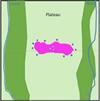
|
|
Groundwater Cleanup System Analysis & Design
Cleanup Guru LLC won a major contract award to cleanup a groundwater contamination site – one of the largest under active remediation in the state. The project, however, did not go particularly well. In fact, the site owners who funded the contract accused the company of malpractice, arguing that the project which aimed to contain the plume actually accelerated the offsite migration to the creeks and to the wetlands and to the lakes downstream. Perform an independent assessment of the cleanup system and develop a new capture system that can contain the groundwater contamination.
(Featured Active Learning Projects- 24)
|
|

|
|
Water Withdrawal Controversy
Prairie Valley Water is installing a high-capacity well to support their expanded bottled water operations. But the company's permit is denied by the state because the state’s water withdrawal assessment tool predicted that their proposed well could adversely impact the nearby trout stream. The company argues that their well will pump deep groundwater which will have no impact on what happens at the surface. You be the judge…should Prairie Valley Water get a permit?
(Featured Active Learning Projects- 24)
|
|

|
|
Well Water Contamination Dispute
Trouble is a brewin' in the valley. Lil' Pete is darn tooting mad 'cause he thinks his well water is being contaminated by Phil's-not-so-fabulous pigs. He is getting ready to sue Phil to cover the losses he faced on last year's bumper crop of mutant tomatoes and he wants to get the facts right before he hires Johnnie Cochran and turns this thing into a national scandal. He hires you to model the groundwater hydrology of the basin to corroborate his theory.
(Featured Active Learning Projects- 24)
|
|

|
|
Well Interference Dispute I
Farmer Buck wants to install a new pump to aid in the irrigation of his crop of… (well, we couldn't tell you that or Farmer Buck would be in a lot of trouble!). Buck's neighbor Willie doesn't want the new well to interfere with his own well's production. Willie has said that he doesn't care how much Buck pumps as long it doesn't draw down the existing well by more than 0.5m. It is up to you to maximize Buck's pumping rate without making Willie go dry.
(Featured Active Learning Projects- 24)
|
|

|
|
Lake Augmentation Controversy
Home owners from a beautiful lake community faced a water problem: their lake was ‘sick’ – it was losing water and lake levels were getting lower. An expert "fixed" the problem by pumping deep groundwater directly into the lake. But years layer, the same problems returned. A second expert says the plan never really worked in the first place. Determine if the lake augmentation project was doomed from the beginning.
(Featured Active Learning Projects- 24)
|
|
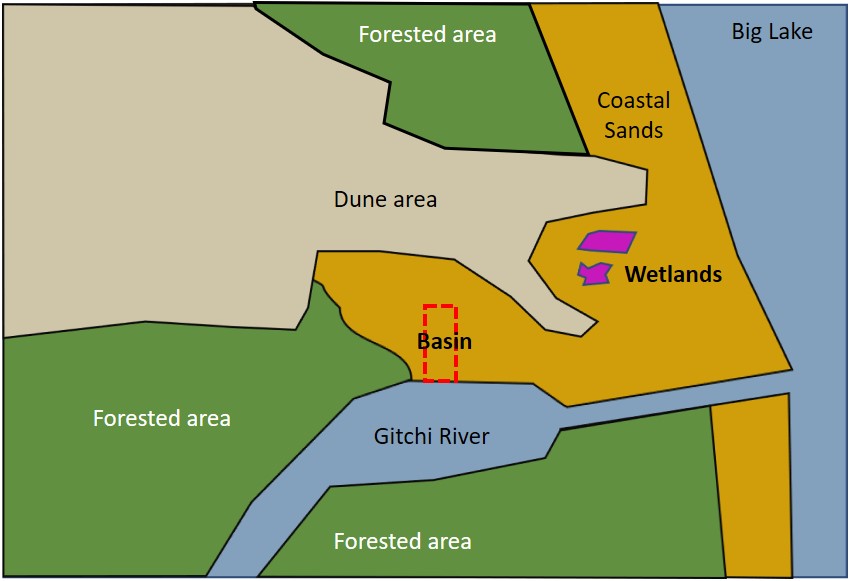
|
|
Dewatering Controversey
Big Dune Shores LLC is proposing to construct a 17 ft deep boat marina near Big Lake at the mouth of the Gitchi River. But they are running into fierce opposition from the local community and environmental activists who argue that the excavation of the new marina will cause the surrounding water table to decline, including in the area of several important interdunal wetland ecosystems. Dune Shores thinks that a sealed marina bottom will eliminate any long-term impact on the water table in the wetland areas, and a quick dewatering operation will result in a temporary drawdown of the water table that is well within natural fluctuations. You be the judge … would the proposed plan by the developer work? Should permits be issued for construction?
(Featured Active Learning Projects- 24)
|
|
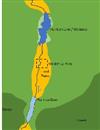
|
|
Dam break and basement flooding dispute
Those Dam Guys LLC was contracted to take on an controversial project - removing the Plankton Dam along an otherwise picturesque stretch of the Plankton River. While they were using a control structure to drawdown the water level in the reservoir, the system failed, causing the downstream river levels to rise by 4m. Several citizens sued Those Dam Guys, claiming their basements were damaged because of the rising groundwater levels caused by high river levels after the dam break. The consultants argued that the basement flooding due was to the inherent surface drainage issues in the clay rich floodplain area, and had nothing to do with river level rise after the dam break. You be the judge..is Those Dam Guys LLC responsible??
(Featured Active Learning Projects- 24)
|
|

|
|
Drinking Water, Food Safety, and Arsenic Groundwater Contamination
Groundwater withdrawals have increased significantly in developing parts of the world to support growing populations and increased domestic food production. But in some of these areas, the groundwater is dangerously contaminated with heavy metals like arsenic, raising concerns over the safety of the food and water being consumed by the population. Investigate a site in the Munshiganj district in Bangladesh and analyze impact of drinking water wells and irrigation wells with respect to the groundwater-surface water interactions that drive the arsenic groundwater contamination problem.
(Featured Active Learning Projects- 24)
|
|
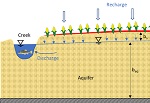
|
|
Accidental Pesticide Spill - I
As a result of a labeling error, a banned water-soluble pesticide was accidentally applied over an
agricultural area.
The area is drained by a small creek which sustains the flow entirely as a result of subsurface drainage from the
agricultural area. Inhabiting the creek is the largest known population of a rare and endangered
species of minnow which is particularly sensitive to environmental contamination. Concentrations of the
pesticide greater than 50 ppb are known to be toxic to this species of minnow.
The state environmental agency proposed to do a 9 mo., $500,000 sampling and modeling study before recommending any action.
Environmentalists propose that a soil-treatment process applied to the upper 20 cm of the soil be initiated immediately. This will cost several million dollars and involved tilling of the soil which would destroy the crops.
The farmers have suggested that the problem be solved by capturing the minnows and holding in a fish hatchery for a few months until the creek contamination has cleared. You are hired to develop a quantitative analysis of these proposals.
(Featured Active Learning Projects- 24)
|
|

|
|
Groundwater Model Calibration Exercise - Fluxes and SWLs
Planning to install a new 250 GPM well at their main facility, a small manufacturer hires you to determine whether their proposed well will cause any problems with the stream and an existing well and whether the new well or the existing well would likely become contaminated by a nearby TCE plume as a result of the operation of the new well. The new well will be operated continuously. The party responsible for the TCE plume has only recently been notified that they must remediate this plume. The State DEQ expects that it will be several years before this happens since it appears the State will have to go to court to force compliance.
(Featured Active Learning Projects- 24)
|
|
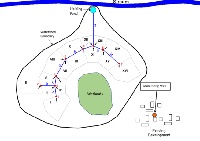
|
|
Storm Water Management Project
You have been hired by a developer to help with the design of a major development complex. The proposed development site, which totals 73.3 acres, sits within a small catchment with a creek that drains into an ecologically important stream at the outlet of the catchment. There is also an existing housing development southeast of proposed development. Because of the water-quality limited designation of the stream, the developer needs to design a storm water system that will minimize the impact on it. One approach is to collect and route stormwater to wetlands adjacent to the development site for natural infiltration into the groundwater system. Another idea is to route storm water through a storm-sewer network and a holding pond to attenuate the flow into the stream and allow for settling of large particulates. Your objective is to determine the feasibility of the two approaches, given the constraints related to streamflow and water table in the area of the existing development.
NOTE: Part 2 can be done independently for courses only interested in performing a groundwater modeling exercise. Contact support@magnet4water.com for additional assistance.
(Featured Active Learning Projects- 24)
|
|

|
|
Introduction to Fluid Mechanics
This introductory lesson touches on experimental, analytical, and computational approaches in the study of fluids. A short series of exercises help to develop a sense of the different approaches and their relative strengths and limitations.
(Featured Active Learning Projects- 24)
|
|

|
|
Stormwater System Design Project 1
You are hired to analyze (and improve upon) a preliminary design for a stormwater management system for the proposed Tech Smith headquarters to be located on the Michigan State University campus in East Lansing, Michigan . Stormwater captured by buildings, sidewalks and other paved areas is to be conveyed to an on-site holding pond through a proposed system of junctions (manholes) and conduits (pipes). Using both spreadsheet approaches and a sophisticated simulation software – MAGNET StormNET - you will design (and then refine) the pipes (including their sizes, slopes, and roughness) and a holding pond (total volume, dimensions, and outflow control structures). You will also assess potential impact of Low Impact Development (LID) controls or other green infrastructure integrated into the system.
(Featured Active Learning Projects- 24)
|
|
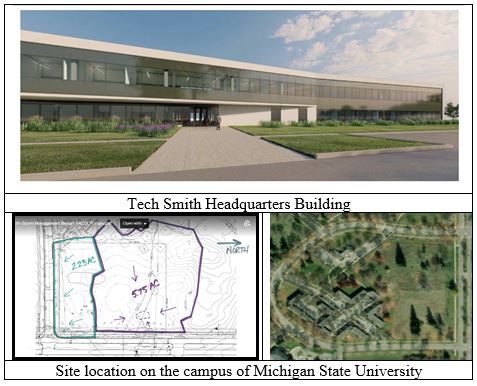
|
|
Stormwater System Design Project 2
Your company has been contracted to design an innovative stormwater management system for the proposed Tech Smith (“Project Hedge”) site, located on the corner of South Harrison Road and Crescent Road within the former Spartan Village development area. The solution must:
• Be aesthetically pleasing and fit into the general landscaping of the MSU campus and the existing stormwater system;
• Incorporate low impact development practices;
• Prevent frequent flooding;
• Prevent further deterioration of the Red Cedar River water quality, including
during storm events;
• Be cost effective;
• Be capable of being permitted from a regulatory standpoint
(Featured Active Learning Projects- 24)
|
|
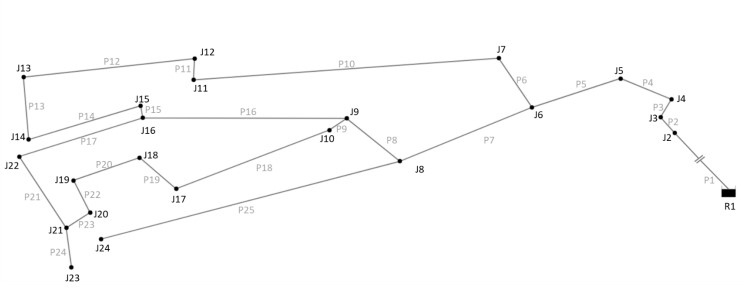
|
|
Drinking Water Distribution System Design 1
A small (but quickly growing community) relies on groundwater to meet its water needs. But over pumping of the aquifer is causing deeper, highly mineralized groundwater to migrate to the shallow subsurface, contaminating the local supply. The community has decided to switch to surface water supply and needs to build a drinking water distribution system that must satisfy certain requirements. The community’s Development Company provided a preliminary design of the distribution system, but the community would like an external review of the design before proceeding with construction. You have been hired analyze the hydraulic feasibility of the preliminary design, particularly with respect to minimum pressure and flow velocity requirements: pressure at all junctions with non-zero demand should exceed the minimum allowable pressure of 15 psi but be less than 165 psi (note: all junctions should have positive pressure). Velocity in the pipes should exceed 1 ft/s but be less than 8 ft/s.
(Featured Active Learning Projects- 24)
|
|
|
|